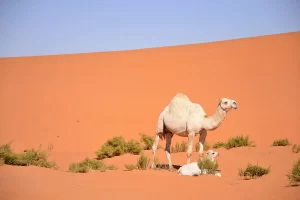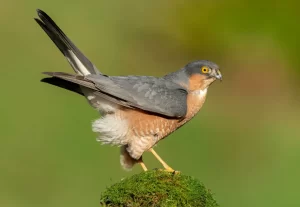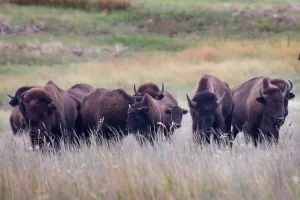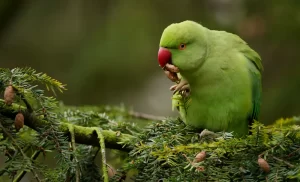Dromedary camels are large hoofed animals with cream to brown colored fur which is short and thick and protects them from the sun in the daytime and keeps them warm during cold nights. Their long legs with two toes on each of their feet foot can spread wide to stop them from sinking into the sand. They have large eyes and good sight, and their large slit-like nostrils give them a good sense of smell and can be closed during dust storms. They have two layers of long eyelashes. Read the full article to know more information about the Dromedary Camels as discussed by Pritish Kumar Halder.

Dromedary camelsIt is the tallest of the three species of camel; adult males stand 1.8–2.4 m (5 ft 11 in – 7 ft 10 in) at the shoulder, while females are 1.7–1.9 m (5 ft 7 in – 6 ft 3 in) tall. Males typically weigh between 400 and 690 kg (880 and 1,520 lb), and females weigh between 300 and 540 kg (660 and 1,190 lb).
Distribution
The Dromedary has not occurred naturally in the wild for nearly 2,000 years.

Range of Dromedary camel
As domestic animals, they are generally found in arid regions in the Middle East, northern India, and Africa, particularly in the Sahara Desert. There is also a significant feral population of dromedary camels in Australian deserts.
Characteristics
The dromedary is the tallest of the three camel species. Adult males range in height between 1.8 and 2.4 m (5.9 and 7.9 ft) at the shoulder; females range between 1.7 and 1.9 m (5.6 and 6.2 ft). Males typically weigh between 400 and 690 kg (880 and 1,520 lb); females range between 300 and 540 kg (660 and 1,190 lb). The distinctive features are its long, curved neck, narrow chest and single hump (the Bactrian camel has two), thick, double-layered eyelashes and bushy eyebrows.
They have sharp vision and a good sense of smell. The male has a soft palate (dulaa in Arabic) nearly 18 cm (7.1 in) long, which it inflates to produce a deep pink sac. The palate, which is often mistaken for the tongue, dangles from one side of the mouth and is used to attract females during the mating season.

Dromedary camel – Characteristics
The coat is generally brown but can range from black to nearly white. Leese reported piebald dromedaries in Kordofan and Darfur in Sudan. Piebald coloration in some camels is thought to be caused by the KITW1 allele of the KIT gene, though there is likely at least one other mutation that also causes white spotting. The hair is long and concentrated on the throat, shoulders and the hump.
The large eyes are protected by prominent supraorbital ridges; the ears are small and rounded. The hump is at least 20 cm (7.9 in) high. The dromedary has long, powerful legs with two toes on each foot. The feet resemble flat, leathery pads. Like the giraffe, dromedaries moves both legs on one side of the body at the same time.
Compared with the Bactrian camel, the dromedary has a lighter build, longer limbs, shorter hairs, a harder palate and an insignificant or absent ethmoidal fissure. Unlike the camelids of the genus Lama, the dromedary has a hump, and in comparison has a longer tail, smaller ears, squarer feet, and a greater height at the shoulder. The dromedary has four teats instead of the two in the Lama species.
Habits and Lifestyle
Dromedary camels are diurnal, generally shy, and usually found in groups of 4 to 6. In a family group, the male is dominant and directs his family from the rear, with females taking turns leading. They tend to travel walking in single file. They are very social and will greet each other by means of blowing in each other’s faces. These camels like to scratch their bodies with their legs, or with their teeth. They also rub against trees and roll in the sand.

Dromedary camel
The species’ distinctive features include its long, curved neck, narrow chest, a single hump (compared with two on the Bactrian camel and wild Bactrian camel), and long hairs on the throat, shoulders and hump. The coat is generally a shade of brown. The hump, 20 cm (7+7⁄8 in) tall or more, is made of fat bound together by fibrous tissue.
Dromedaries are mainly active during daylight hours. They form herds of about 20 individuals, which are led by a dominant male. They feed on foliage and desert vegetation; several adaptations, such as the ability to tolerate losing more than 30% of its total water content, allow it to thrive in its desert habitat. Mating occurs annually and peaks in the rainy season; females bear a single calf after a gestation of 15 months.
Diet and Nutrition
Camels are herbivores (folivores, graminivores) and their diet consists mostly of foliage, dry grasses, and desert vegetation – mostly thorny plants.

DROMEDARY CAMEL – diet
Their thick lips allowing them to eat things that other animals can’t, like thorny plants. When looking for food, they spread over large areas and taking from each plant only a few leaves. It is important that they fill up on available water. Within just 13 minutes they are able to take in 30 gallons (113 liters) of water.
Mating Habits
Dromedary camels are polygamous. Their breeding season is usually from November and March. Gestation lasts up to 13 months and one calf is born, or occasionally twins.

Dromedary camel – Feeding
The calf can stand within 8 hours. It remains under the herd’s protection until it is old enough to become independent. Nursing and maternal care continue for 1 to 2 years. Both young males and young females might mature by 3 to 5 years of age, though successful breeding could take longer
Population number
There are no true wild dromedaries anymore. The number of domestic dromedaries is about 15 million, giving them common status. As of 2013, the feral population of Australia was estimated at around 300,000 individuals.
Fun Facts for Kids
- Camels only sweat in temperatures of 106°F (41C) or higher.
- Camels are born with no hump.

Dromedary camels with babies
- Most camels will only spit when provoked, despite their reputation as spitters.
- Water is not stored in camels’ humps, which consist of fat.
- When camels use up the fat stored in their hump, it will get smaller. It will fill up with fat Again when they eat and drink.
- Camels make the sounds of moans, groans, and deep bellows. A camel’s noise was used as the voice of Chewbacca in Star Wars movies.
- Camels can live as long as six months with no food or water.










